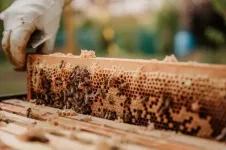(Press-News.org) A team led by a social work researcher at The University of Toledo has published the first empirical evidence that emotional support animals can provide quantifiable benefits to individuals with serious mental illness who are experiencing depression, anxiety and loneliness.
The research brings credence to the many anecdotal reports of emotional support animals having positive impacts on chronic mental health issues.
"This is the first peer-reviewed, published scientific evidence that emotional support animals may benefit people's mental health," said Dr. Janet Hoy-Gerlach, a professor of social work and the lead investigator on the project. "My hope is that our pilot study catalyzes additional research in this area with more rigorous methodology."
Frequently misunderstood and often maligned, emotional support animals are neither household pets nor highly trained service animals.
Emotional support animals need no formal training or certification but are recognized in writing by a health or mental healthcare professional as therapeutically needed for a person with a health or mental health condition. The person's condition must meet the definition of a disability under the Fair Housing Act, a federal housing policy that protects against disability-related housing discrimination.
While there is a sizeable body of research on the benefits of pets that helps to inform the recommendation of emotional support animals in healthcare, there has been no previously published scientific research focusing specifically on the benefits of emotional support animals.
In the UToledo pilot study, researchers from the College of Health and Human Services followed a small group of study participants who were paired with a shelter dog or cat through the Hope and Recovery Pet Program, an innovative community partnership of UToledo, the Toledo Humane Society and ProMedica.
Participants in the study, all of whom met low-income criteria and were identified as at risk of social isolation, were referred by their mental health providers.
Hoy-Gerlach and her collaborators regularly tested participants for changes in a trio of biomarkers related to stress and bonding, and administered surveys about participants' depression, anxiety and loneliness prior to adoption and at the end of the 12-month study period.
At the conclusion of the study, they found a statistically significant decrease in participants' depression, anxiety and loneliness as measured by standardized scales.
The researchers also observed a consistent pattern of higher amounts of the bonding hormone oxytocin and lower amounts of the stress hormone cortisol after participants engaged in focused interactions with their emotional support animal for 10-minute periods.
While not a statistically significant finding, the analysis hinted that participants may have benefited from their animals at a biological level.
"The biomarker findings, along with the standardized stress, anxiety and loneliness surveys and qualitative interviews together suggest insights into how emotional support animals may help reduce symptoms and loneliness associated with chronic mental illness," Hoy-Gerlach said. "We can't make any generalizations or big sweeping claims, but the findings are pretty straightforward for this particular group of people."
Researchers observed the highest oxytocin increase at the 12-month mark, which could indicate participants' bond with their dog or cat had strengthened over time.
Qualitative research corroborated this idea: In open-ended interviews, study participants talked about feeling much more emotionally attached to their respective animals at the end of the study.
The research, published Monday in the Human-Animal Interaction Bulletin, builds on Hoy-Gerlach's previous research into the human-animal bond and could lead the way toward new thinking about how emotional support animals can be implemented as a strategy in managing chronic mental health issues.
A trained clinical social worker who has extensive experience in counseling, crisis work and public mental health, Hoy-Gerlach's interest in studying how animals affect mental health began after working on assessments for suicide and finding people's pets were frequently a protective factor.
She has since devoted much of her academic research to the topic. In 2017, she published the book "Human-Animal Interactions: A Social Work Guide."
While the recently published study was small in nature, Hoy-Gerlach said it could serve as a major step toward demonstrating the value of emotional support animals for human health.
"We have seen a significant increase in social isolation because of COVID-19, particularly among those most vulnerable to its effects. While our research was initiated before the pandemic, the findings couldn't be more applicable," she said. "Now more than ever, we need to be thinking about leveraging every resource at our disposal."
Such efforts can benefit both people and animals in need. The Hope and Recovery Pet Program exemplifies this, Hoy-Gerlach said, providing emotional support animals for people with mental illness while placing homeless animals into permanent, loving homes.
"The human-animal bond is an underutilized resource for both human and animal well-being," Hoy-Gerlach said.
Hoy-Gerlach's findings also serve to push back against the idea that emotional support animals are little more than a scheme aimed at exploiting the system to give household pets special status.
"The narrative of emotional support animal fraud has unfortunately gained traction in the media and public eye, and that obscures the very real ways in which emotional support animals can benefit people," Hoy-Gerlach said. "For the individuals in our study who are living with chronic mental illness, being paired with an appropriate animal appears to have demonstrable positive effects on their well-being."
INFORMATION:
The project was funded by the Kenneth A. Scott Charitable Trust.
FRANKFURT. As first pointed out by the German astronomer Karl Schwarzschild, black holes bend space-time to an extreme degree due to their extraordinary concentration of mass, and heat up the matter in their vicinity so that it begins to glow. New Zealand physicist Roy Kerr showed rotation can change the black hole's size and the geometry of its surroundings. The "edge" of a black hole is known as the event horizon, the boundary around the concentration of mass beyond which light and matter cannot escape and which makes the black hole "black". Black holes, theory predicts, can be described by a handful ...
When scientists hunt for life, they often look for biosignatures, chemicals or phenomena that indicate the existence of present or past life. Yet it isn't necessarily the case that the signs of life on Earth are signs of life in other planetary environments. How do we find life in systems that do not resemble ours?
In groundbreaking new work, a team* led by Santa Fe Institute Professor Chris Kempes has developed a new ecological biosignature that could help scientists detect life in vastly different environments. Their work appears as part of a special issue of theBulletin ...
The chemical bisphenol F (found in plastics) can induce changes in a gene that is vital for neurological development. This discovery was made by researchers at the universities of Uppsala and Karlstad, Sweden. The mechanism could explain why exposure to this chemical during the fetal stage may be connected with a lower IQ at seven years of age - an association previously seen by the same research group. The study is published in the scientific journal Environment International.
"We've previously shown that bisphenol F (BPF for short) may be connected with children's cognitive development. However, with this study, we can now begin to understand which biological mechanisms may explain such a link, which is unique for an epidemiological study." ...
A new study provides public health planning authorities with a method of calculating the number of COVID-19 isolation beds they would need for people experiencing homelessness based on level of infection in the city. The research holds promise for controlling spread of the virus - or future infectious diseases - in a population that is highly vulnerable and less likely than many others to access health care services.
The report, developed to support public health decision-making in Austin, Texas, was recently published by PLOS ONE. The paper's first author is an undergraduate student at The University of Texas at Austin, Tanvi Ingle, who harnessed ...
In April 2017, a landslide in Mocoa, Colombia, ripped through a local town, killing more than 300 people. Nicolás Pérez-Consuegra grew up about 570 miles north in Santander, Colombia, and was shocked as he watched the devastation on television. At that time, he was an undergraduate intern at the Smithsonian Tropical Research Institute in Panama. As a budding geologist raised hiking the tropical mountains of Colombia, he wondered, what causes greater erosion in some areas of the mountains than in others? And, is it tectonic forces - where Earth's tectonic plates slide against one another leading to the formation of steep mountains - or high precipitation rates, that play a more important role in causing erosion within that region?
To answer those questions would require a geological ...
Scientists have discovered that the way in which neurons are connected within regions of the brain, can be a better indicator of disease progression and treatment outcomes for people with brain disorders such as epilepsy.
Many brain diseases lead to cell death and the removal of connections within the brain. In a new study, published in Human Brain Mapping, a group of scientists, led by Dr Marcus Kaiser from the School of Medicine at the University of Nottingham, looked at epilepsy patients undergoing surgery.
They found that changes in the local network within brain regions can be a better predictor ...
More than 90 years ago, astronomer Edwin Hubble observed the first hint of the rate at which the universe expands, called the Hubble constant.
Almost immediately, astronomers began arguing about the actual value of this constant, and over time, realized that there was a discrepancy in this number between early universe observations and late universe observations.
Early in the universe's existence, light moved through plasma--there were no stars yet--and from oscillations similar to sound waves created by this, scientists deduced that the Hubble constant was about 67. This means the universe expands about 67 kilometers per second faster every 3.26 million light-years.
But this observation differs when scientists look at the universe's ...
BOSTON - Dana-Farber Cancer Institute researchers are presenting dozens of research studies at the 2021 Annual Meeting of the American Society of Clinical Oncology (ASCO). The studies will be presented during the virtual program on June 4-8, 2021. ASCO is the world's largest clinical cancer research meeting, attracting more than 30,000 oncology professionals from around the world.
Toni K. Choueiri, MD, the director of the Lank Center for Genitourinary Oncology at Dana-Farber, will present results from the randomized, double-blind, phase III KEYNOTE-564 trial evaluating pembrolizumab versus placebo after surgery in patients with renal cell carcinoma (abstract LBA5) during ASCO's Plenary Session on Sunday, June ...
CHAMPAIGN, Ill. -- Solid-state batteries pack a lot of energy into a small space, but their electrodes are not good at keeping in touch with their electrolytes. Liquid electrolytes reach every nook and cranny of an electrode to spark energy, but liquids take up space without storing energy and fail over time. Researchers are now putting solid electrolytes in touch with electrodes made of strategically arranged materials - at the atomic level - and the results are helping drive better solid-state battery technologies.
A new study, led by University of Illinois Urbana-Champaign materials science and engineering professor Paul Braun, postdoctoral research associate Beniamin Zahiri, and Xerion Advanced Battery Corp. director of research and development ...
The University of Maryland (UMD) co-published a new review paper in the Annual Review of Resource Economics to examine pollinators from both an economic and ecological perspective, providing much needed insight into the complexities of valuing pollination. Pollinators are not only a critical component of a healthy ecosystem, but they are also necessary to produce certain foods and boost crop yields. While native and wild pollinators (whether they be certain bee species, other insects and animals, or just the wind) still play an important role, managed honey bee colonies are commercially trucked around the U.S. to meet the need for pollination services in agricultural products. Recent reports of ...





